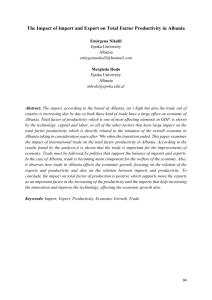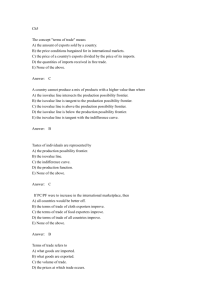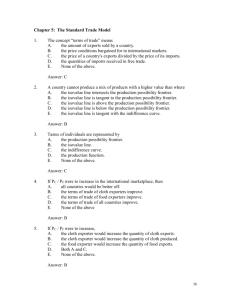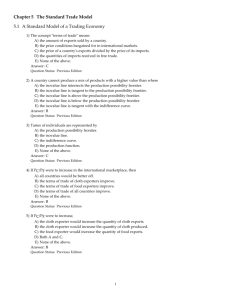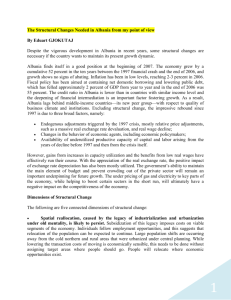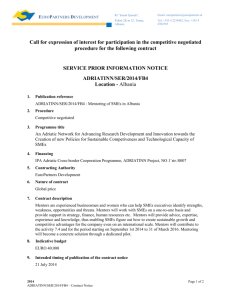Document
advertisement
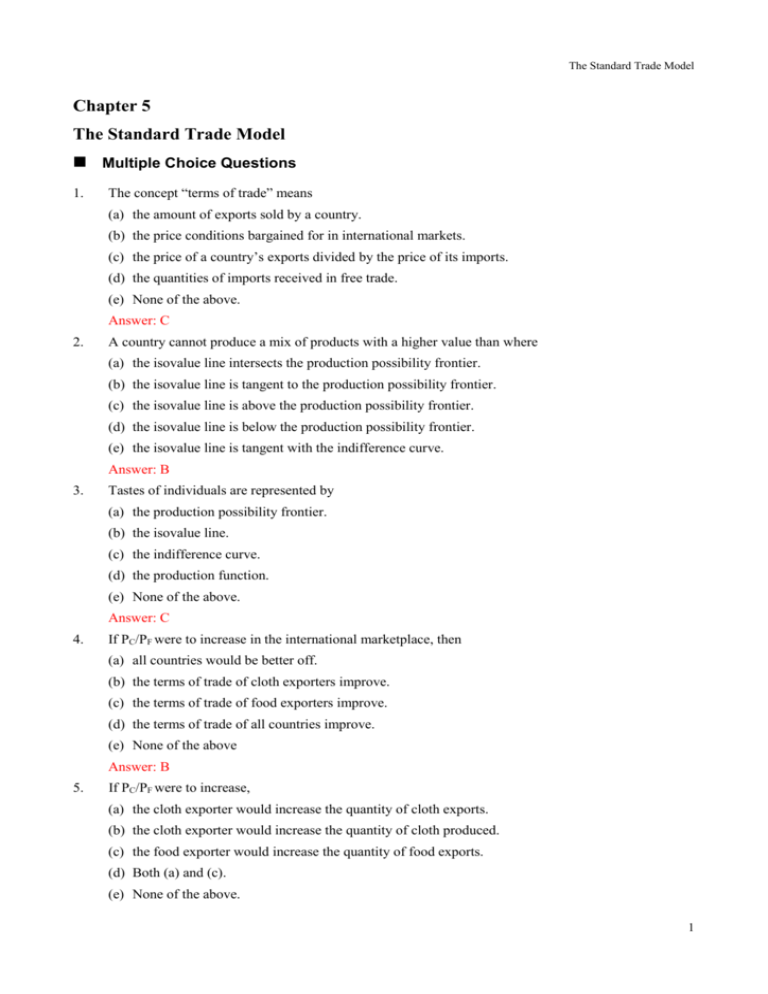
The Standard Trade Model Chapter 5 The Standard Trade Model Multiple Choice Questions 1. The concept “terms of trade” means (a) the amount of exports sold by a country. (b) the price conditions bargained for in international markets. (c) the price of a country’s exports divided by the price of its imports. (d) the quantities of imports received in free trade. (e) None of the above. Answer: C 2. A country cannot produce a mix of products with a higher value than where (a) the isovalue line intersects the production possibility frontier. (b) the isovalue line is tangent to the production possibility frontier. (c) the isovalue line is above the production possibility frontier. (d) the isovalue line is below the production possibility frontier. (e) the isovalue line is tangent with the indifference curve. Answer: B 3. Tastes of individuals are represented by (a) the production possibility frontier. (b) the isovalue line. (c) the indifference curve. (d) the production function. (e) None of the above. Answer: C 4. If PC/PF were to increase in the international marketplace, then (a) all countries would be better off. (b) the terms of trade of cloth exporters improve. (c) the terms of trade of food exporters improve. (d) the terms of trade of all countries improve. (e) None of the above Answer: B 5. If PC/PF were to increase, (a) the cloth exporter would increase the quantity of cloth exports. (b) the cloth exporter would increase the quantity of cloth produced. (c) the food exporter would increase the quantity of food exports. (d) Both (a) and (c). (e) None of the above. 1 Answer: B 6. If PC/PF were to increase, (a) world relative quantity of cloth supplied and demanded would increase. (b) world relative quantity of cloth supplied and demanded would decrease. (c) world relative quantity of cloth supplied would increases. (d) world relative quantity of cloth demanded would decrease. (e) None of the above. Answer: C 7. When the production possibility frontier shifts out relatively more in one direction, we have (a) biased growth. (b) unbiased growth. (c) immiserizing growth. (d) balanced growth. (e) imbalanced growth. Answer: A 8. Immiserizing growth is (a) likely to occur if the exporting country is poor. (b) likely to occur if the exporting country is rich. (c) likely to occur when terms of trade change. (d) likely to occur if relative supplies are elastic. (e) None of the above. Answer: E 9. If the U.S. Agency for International Development transfers funds to poor countries in Sub-Saharan Africa, this must (a) worsen the U.S. terms of trade. (b) improve the U.S. terms of trade. (c) worsen the terms of trade of the African aid recipients. (d) improve the terms of trade of the African aid recipients. (e) None of the above. Answer: E 10. If the poor USAID recipient countries have a higher marginal propensity to consume each and every product than does the United States, then such aid will (a) worsen the U.S. terms of trade. (b) improve the U.S. terms of trade. (c) leave the world terms of trade unaffected. (d) worsen the terms of trade of both donor and recipient countries. (e) None of the above. Answer: B 11. If the U.S. has a higher marginal propensity to consume (MPC) imports as compared to both its MPC for exportables and nontradables, then such aid will 2 The Standard Trade Model (a) worsen the U.S. terms of trade. (b) improve the U.S. terms of trade. (c) leave the world terms of trade unaffected. (d) worsen the terms of trade of both donor and recipient countries. (e) None of the above. Answer: B 12. If the U.S. (a large country) imposes a tariff on its imported good, this will tend to (a) have no effect on terms of trade. (b) improve the terms of trade of all countries. (c) improve the terms of trade of the United States. (d) cause a deterioration of U.S. terms of trade. (e) raise the world price of the good imported by the United States. Answer: C 13. If the U.S. (a large country) imposes a tariff on its imported good, this will (a) have no effect on economic welfare. (b) improve the terms of trade of all countries. (c) improve the economic welfare of the United States. (d) harm the economic welfare of U.S.’ trading partners. (e) None of the above Answer: D 14. A country will be able to consume a bundle which is not attainable solely from domestic production only if (a) the world terms of trade differ from its domestic relative costs. (b) the country specializes in one product. (c) the country avoids international trade. (d) the world terms of trade equal the domestic relative costs. (e) None of the above. Answer: A 15. Terms of trade refers to (a) what goods are imported. (b) what goods are exported. (c) the volume of trade. (d) the prices at which trade occurs. (e) None of the above. Answer: D 16. If a country’s (net-barter) terms of trade increase (“improve”) we know from this that economic welfare in this country (a) increases 3 (b) increases, but only relative to that of its trade partners (c) is unchanged (d) decreases (e) None of the above Answer: A 17. If points a and b are both on the production possibility frontier of a country, then (a) consumers are indifferent between the two bundles. (b) producers are indifferent between the two bundles. (c) at any point in time, the country could produce both. (d) Both cost the same. (e) The country could produce either of the two bundles. Answer: E 18. If the economy is producing at point a on its production possibility frontier, then (a) all of the country’s workers are specialized in one product. (b) all of the county’s capital is used for one product. (c) all of the county’s workers are employed. (d) all of its capital is used, but not efficiently. (e) None of the above. Answer: C 19. If at point A on the production possibility frontier, and the community indifference curve cuts through point A from northwest to southeast, then the optimal autarky production bundle is (a) at point A. (b) to the right of point A. (c) to the left of point A. (d) to the northeast of point A. (e) to the southwest of point A. Answer: B 20. A bundle indicated by a point to the northeast of the production possibility frontier is (a) unattainable at a point in time. (b) unattainable at a point in time without international trade. (c) unattainable at a point in time without domestic trade. (d) unattainable as a consumption point. (e) None of the above. Answer: B 21. If a small country were to levy a tariff on its imports then this would (a) have no effect on that country’s economic welfare. (b) increase the country’s economic welfare. (c) decrease the country’s economic welfare. (d) change the terms of trade. (e) None of the above. 4 The Standard Trade Model Answer: C 22. After WWI, Germany was forced to make large reparations—transfers of real income- to France. If the marginal propensity to consume was equal in both countries, and if France’s demand was biased toward food (relative to Germany’s demand pattern) then we would expect to find (a) the world’s relative price for food remains unchanged. (b) the world’s relative price for food increase. (c) the world’s relative price for food decrease. (d) the world relative price for both food and non-food rise. (e) None of the above. Answer: B 23. If a country lent money to another, this must (a) lower the terms of trade of the recipient country. (b) lower the terms of trade of both countries. (c) improve the terms of trade of the recipient country. (d) improve the terms of trade of the donor country (e) None of the above. Answer: E 24. During the 19th Century, economic growth of the major trading countries was biased toward manufactures and away from food. The less developed countries of that time were net exporters of food. From this information, we would expect to have observed (a) falling terms of trade for the less developed countries. (b) improving (rising) terms of trade for the less developed countries. (c) no change at all in the terms of trade of the less developed countries. (d) a decrease in the relative price of food. (e) None of the above. Answer: B 25. Immiserizing growth could occur to (a) a poor country experiencing export-biased economic growth. (b) a poor country experiencing import-biased economic growth. (c) a poor country experiencing growth in its non-traded sector. (d) a poor country experiencing capital-intensive biased growth. (e) None of the above. Answer: A 26. A large country experiencing import-biased economic growth will tend to experience (a) positive terms of trade. (b) deteriorating terms of trade. (c) improving terms of trade. (d) immiserizing terms of trade. 5 (e) None of the above. Answer: C 27. In the period preceding the recent Financial Crisis in Asia, the South East Asian countries were receiving large inflows of financial capital. Following John Maynard Keynes’ theory, this should have caused (a) a glut in their banking asset situation. (b) an improvement in their terms of trade. (c) deterioration in their terms of trade. (d) a fluctuation upward and then downward in their terms of trade. (e) None of the above. Answer: B 28. If Slovenia is a small country in world trade terms, then if it imposes a large series of tariffs on many of its imports, this would (a) have no effect on its terms of trade. (b) improve its terms of trade. (c) deteriorate its terms of trade. (d) decrease its marginal propensity to consume. (e) None of the above. Answer: A 29. If Slovenia is a large country in world trade, then if it imposes a large set of tariffs on many of its imports, this would (a) have no effect on its terms of trade. (b) improve its terms of trade. (c) deteriorate its terms of trade. (d) decrease its marginal propensity to consume. (e) None of the above. Answer: B 30. If Slovenia were a large country in world trade, then if it instituted a large set of subsidies for its exports, this must (a) have no effect on its terms of trade. (b) improve its terms of trade. (c) deteriorate its terms of trade. (d) decrease its marginal propensity to consume. (e) None of the above. Answer: C 31. If Slovenia were a large country in world trade, then if it instituted a large set of subsidies for its exports, this must (a) cause retaliation on the part of its trade partners. (b) harm Slovenia’s real income. (c) improve Slovenia’s real income. 6 The Standard Trade Model (d) improve the real income of its trade partners. (e) None of the above. Answer: D 32. If there are no international loans or capital flows, then if a country’s terms of trade improve, we would find that (a) the value of its exports exceeds the value of its imports. (b) the value of its exports becomes less than that of its imports. (c) the value of its exports exactly equals that of its imports. (d) the quantity of its exports equals that of its imports. (e) None of the above. Answer: A 33. If the U.S. Agency for International Development transfers funds to poor countries in Sub-Saharan Africa, the conventional assumption, following Keynes’ analysis would presume that this would tend to (a) worsen the U.S. terms of trade. (b) improve the U.S. terms of trade. (c) worsen the terms of trade of the African aid recipients. (d) improve the terms of trade of the African aid recipients. (e) None of the above. Answer: A Quantitative/Graphing Problems 1. Albania refused to engage in international trade for ideological reasons. To maximize its economic welfare it would choose to produce at which point in the diagram above? Suppose the PA/PB at point a was equal to 1. Given this information, in which good (A or B) does Albania enjoy a comparative advantage? Now that the Cold War is over, Albania is interested in obtaining economic welfare gains from trade. The relevant international relative price is PA/PB 2. Albania would therefore choose to produce at which point (a, b, or c)? Given this additional information, in which good does Albania enjoy a comparative advantage? 7 Answer: Albania would choose to produce at point a. With no reference to world terms of trade, one cannot establish Albania’s comparative advantage. Later, when Albania discovers that the relative price of A equals twice the price of b, it knows that it has a comparative advantage in A. Therefore Albania would produce at production point b. 2. Now, suppose that the relative price of A , PA/PB 0.5. Would Albania still be able to gain from trade? If so, where would be its production point? Given the information in this question, where is Albania’s comparative advantage? Answer: Yes. As long as the world’s terms of trade differed from those of Albania, that country stands to gain from international trade. In this particular case, its point of production with trade would be at point c. 3. Suppose, as a result of various dynamic factors associated with exposure to international competition, Albania’s economy grew, and is now represented by the rightmost production possibility frontier in the Figure above. If its point of production with trade was point c, would you consider this growth to be export-biased or import biased? If Albania were a large country with respect to the world trade of A and B, how would this growth affect Albania’s terms of trade? Its real income? Answer: If point c is the production point with trade, then Albania has a comparative advantage in good B. Therefore, from the shape of the new production possibility frontier (as compared to the original one), this is clearly an export-biased growth. This ceteris paribus would tend to worsen Albania’s terms of trade. The terms of trade effect would, again ceteris paribus, worsen its real income. However, the growth itself acts in the opposite direction. 4. Suppose, as a result of various dynamic factors associated with exposure to international competition, Albania’s economy grew, and is now represented by the rightmost production possibility frontier in the Figure above. If its point of production with trade was point b, would you consider this growth to be export-biased or import biased? If Albania were a large country with respect to the world trade of A and B, how would this growth affect Albania’s terms of trade? Its real income? What if Albania were a small country? Answer: If the production with trade point was point b, then the observed growth is a case of importbiased growth, and would improve Albania’s terms of trade. If Albania were a small country, the world’s terms of trade would not change at all. In such a case, economic growth (with no induced change in income distributions) would always increase its real income. 8

